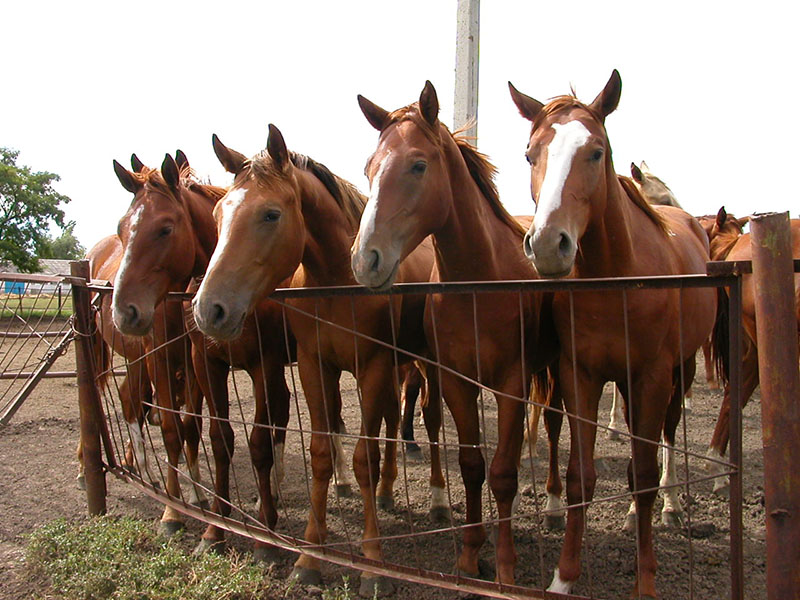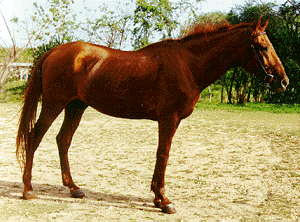Budyonny Horses
 The Budyonny originated in the former Soviet Union. The breed was developed from a
cross of the Russian Don with the English Thoroughbred. It was formed by Marshal Budyonny, who was a hero of the Russian Revolution, with
the intention of creating a military riding horse. The primary development of the
breed took place at the military stud farm in Rostov in the years following the fall
of the Tsar.
The Budyonny originated in the former Soviet Union. The breed was developed from a
cross of the Russian Don with the English Thoroughbred. It was formed by Marshal Budyonny, who was a hero of the Russian Revolution, with
the intention of creating a military riding horse. The primary development of the
breed took place at the military stud farm in Rostov in the years following the fall
of the Tsar.
The breed stands approximately 15.1 - 16 hands. The coat is generally chestnut, but may be bay, gray, or more rarely: brown or black.
The breed is well suited as a riding horse or for light carriage and is a good jumper. The Budyonny has free and easy movement at all gaits making it very well suited as a sporting horse for modern equestrian events.
The Budyonny originated in the former Soviet Union. The breed was developed from a cross between the Russian Don with the English Thoroughbred. Of the 657 mares used to produce the Budyonny, 359 were Anglo-Don, 261 Anglo-Don X Chernomor, and 37 Anglo-Chernomor. The Anglo-Don may rightly be called the founders of the Budyonny Breed. The Russian Don has also contributed the golden chestnut color which prevails in the Budyonny breed, although black and bay have been seen. It was formed by Marshal Budyonny, who was a hero of the Russian Revolution, with the intention of creating a military riding horse. The primary development of the breed took place at the military stud farm in Rostov in the years following the fall of the Tsar.
The breed stands approximately 15.1 - 16 hands. The coat is generally chestnut, but may be bay, gray, or more rarely, brown or black.
 The modern Budyonny is a horse of good height with a clean, solid build and heavily
muscled body. The Budyonny is a good-tempered and energetic, an animal easily broken.
The breed is well suited as a riding horse or for light carriage and is a good jumper.
The Budyonny has free and easy movement at all gaits making it very well suited as
a sporting horse for modern equestrian events.
The modern Budyonny is a horse of good height with a clean, solid build and heavily
muscled body. The Budyonny is a good-tempered and energetic, an animal easily broken.
The breed is well suited as a riding horse or for light carriage and is a good jumper.
The Budyonny has free and easy movement at all gaits making it very well suited as
a sporting horse for modern equestrian events.
The Budyonny is capable of adapting to extremely severe conditions. In the 1950's there was an experiment, a number of Budyonny horses were turned loose on a large island in Manych Lake in the Rostov district, creating "Budyonny mustangs." After some years there, the population rose appreciably. In 1985 only fourteen mares, and fourteen colts were found. The Budyonny have retained the chestnut and sorrel color and live in three groups governed by stallions, three other stallions live alone. The Budyonny horses live on the island without human assistance and have typical traits of wild horses. The number of horses that were originally freed on the island is unknown to the author, but the experiment has proven authorities that a breed such as the Budyonny is able to adapt and survive for an extended period without shelter provided by humans or supplemental feeding.
References
Cesar D. Beltran & Victoria Northrop de Beltran, Santo Domingo, Dominican Republic
Hendricks, Bonnie L., International Encyclopedia of Horse Breeds, Univ of Oklahoma Press, 1995
